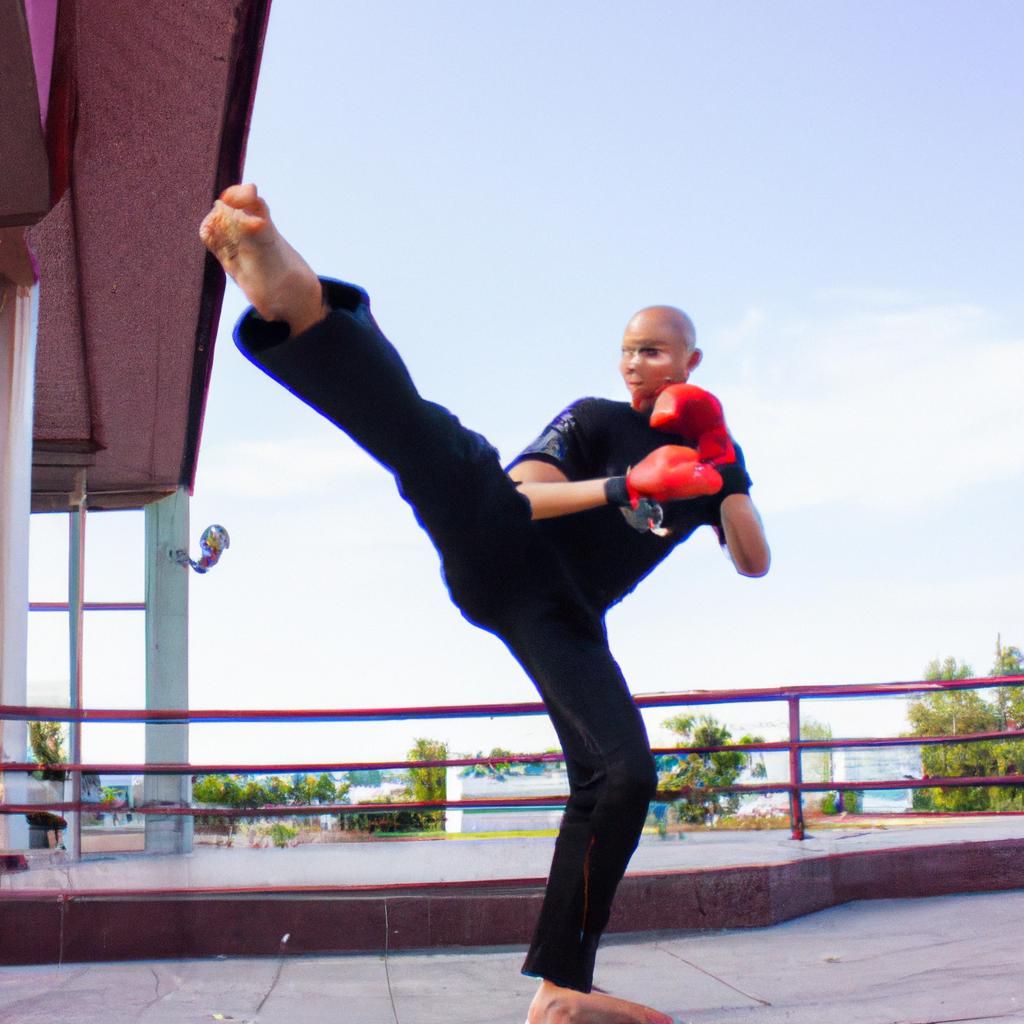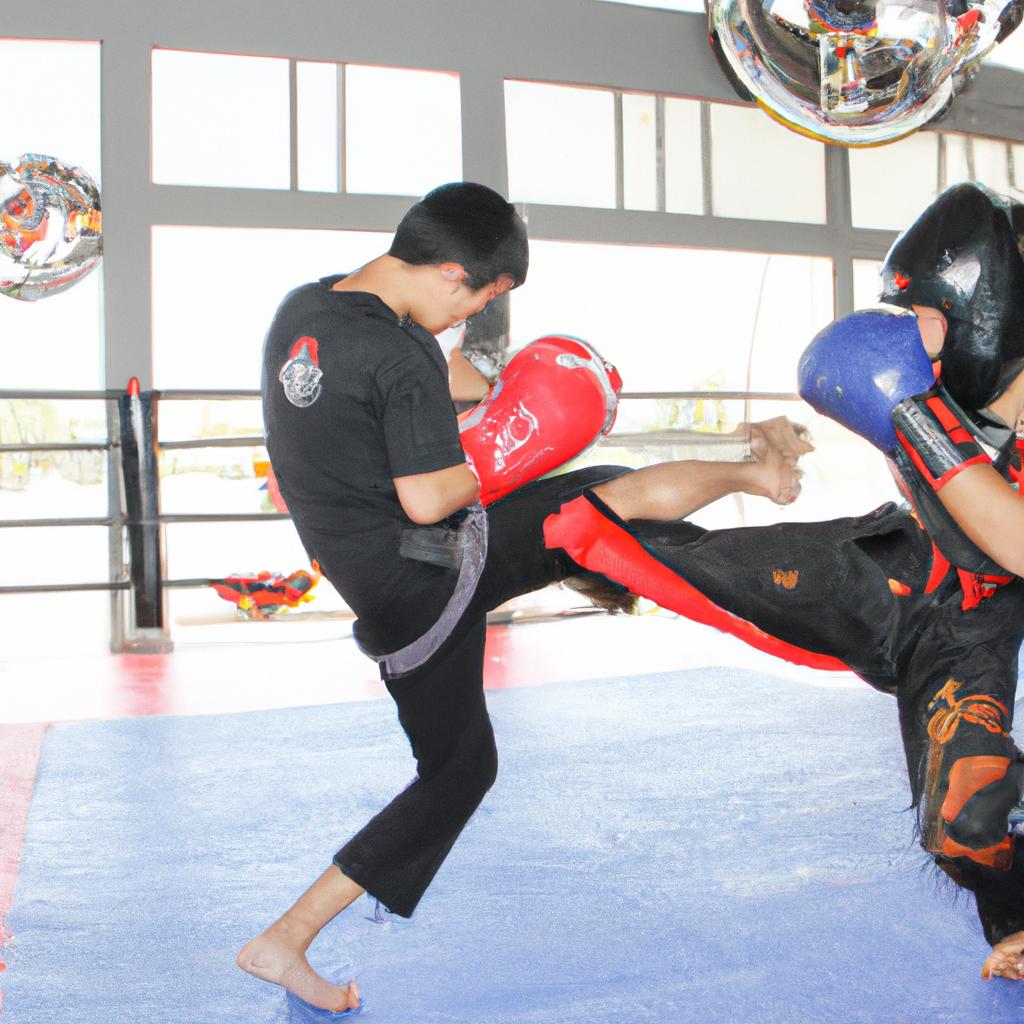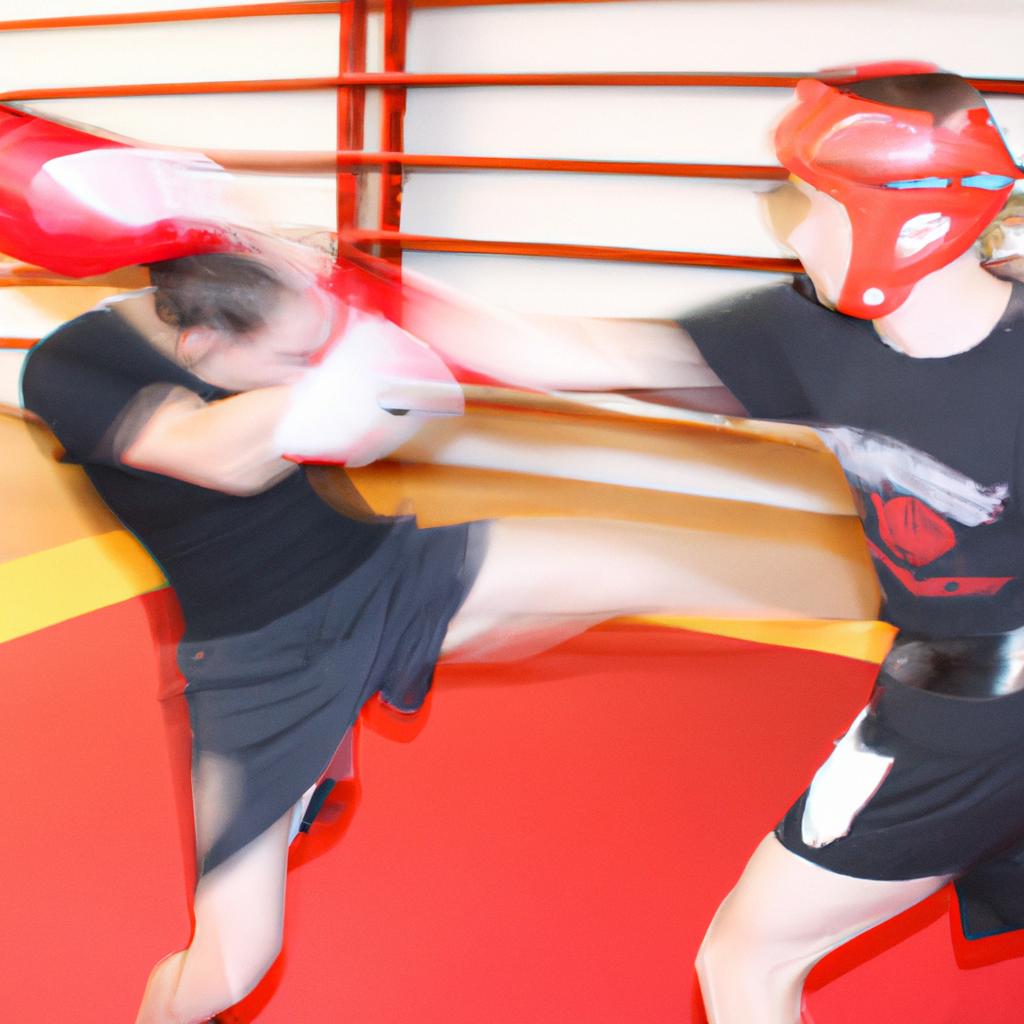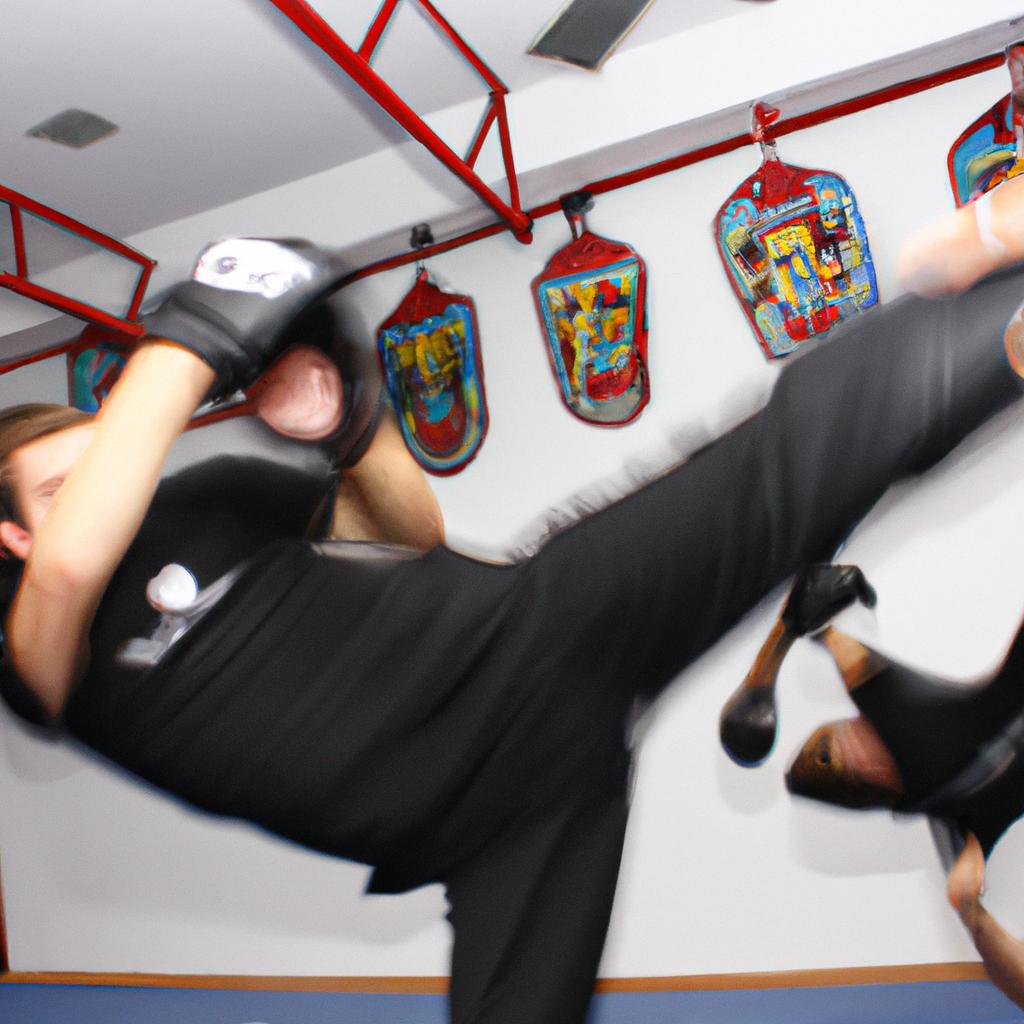Muay Thai, also known as the Art of Eight Limbs, has gained significant recognition and popularity within the realm of Mixed Martial Arts (MMA). With its roots deeply embedded in Ancient Thailand, Muay Thai offers a rich historical tapestry that intertwines with the evolution of MMA. To illustrate this relationship, let us consider a hypothetical scenario: imagine an aspiring MMA fighter who seeks to enhance their striking skills. In their quest for martial mastery, they delve into the world of Muay Thai, uncovering not only a powerful combat system but also a journey through time.
The origins of Muay Thai can be traced back thousands of years to ancient battlefields where hand-to-hand combat was a way of life. Over time, it evolved from being solely focused on warfare to becoming an integral part of cultural identity and sporting prowess in Thailand. This transition is exemplified by legendary figures such as Nai Khanom Tom, whose remarkable victory against Burmese fighters during the Ayutthaya Kingdom era played a pivotal role in establishing Muay Thai’s reputation as both an effective fighting style and a symbol of national pride.
As MMA emerged as a global phenomenon in recent decades, practitioners quickly recognized the value of incorporating different martial arts disciplines into their training reg imen. Muay Thai, with its unique blend of striking techniques utilizing fists, elbows, knees, and shins, became a natural fit for MMA fighters looking to enhance their stand-up game.
One of the key aspects that sets Muay Thai apart from other striking arts is its emphasis on clinch work. The clinch allows fighters to control their opponent’s movements, deliver devastating knee strikes, and set up powerful sweeps or throws. This aspect of Muay Thai has proven highly effective in the close-quarters combat scenarios often encountered in MMA fights.
Moreover, Muay Thai’s training methods focus on developing explosive power, endurance, and mental toughness. The rigorous conditioning routines involved in Muay Thai training can greatly enhance an MMA fighter’s overall physical fitness and resilience inside the cage.
Furthermore, the technical proficiency required in executing Muay Thai techniques provides fighters with a wide array of offensive tools at their disposal. The ability to effectively utilize punches, kicks, knees, and elbows gives MMA fighters a versatile arsenal to attack their opponents from various angles and distances.
In recent years, many successful MMA fighters have showcased their expertise in Muay Thai by incorporating its techniques into their fighting style. Fighters like Anderson Silva, Joanna Jedrzejczyk, and Valentina Shevchenko have demonstrated the effectiveness of integrating Muay Thai into MMA through their impressive performances and knockout victories.
Ultimately, for our aspiring MMA fighter seeking to enhance their striking skills within the context of mixed martial arts competition, delving into the world of Muay Thai would provide them with a comprehensive system that combines centuries-old traditions with modern combat strategies. It would offer them not only an opportunity to refine their striking techniques but also a deeper understanding of the historical roots that connect martial arts across time.
Origins of Muay Thai
Origins of Muay Thai
One example that highlights the intriguing origins of Muay Thai is the story of Nai Khanom Tom, a legendary fighter from Thailand. In 1767, during the Burmese invasion of Ayutthaya, Nai Khanom Tom was captured and taken as a prisoner to Burma. As part of a festival held by the Burmese king, he was pitted against ten other fighters in hand-to-hand combat. Utilizing his extraordinary skills in what would later be recognized as Muay Thai, Nai Khanom Tom defeated all his opponents with remarkable agility and technique.
The history of Muay Thai dates back thousands of years and has evolved through various cultural influences. Originating in ancient Siam (present-day Thailand), it began as a form of self-defense for soldiers engaged in warfare. Initially known as “Muay Boran,” meaning ancient boxing or traditional martial arts, this fighting style involved strikes using fists, elbows, knees, and shins. Over time, it developed into a popular sport practiced not only by warriors but also by common people seeking physical fitness.
To understand the historical context surrounding Muay Thai’s development into an esteemed martial art today, we must consider several key factors:
- Cultural Significance: Muay Thai holds deep cultural significance within Thailand as it embodies their national identity and heritage.
- Training Methods: The rigorous training methods employed in Muay Thai focus on building strength, endurance, discipline, and mental fortitude.
- Spiritual Elements: Alongside its physical aspects, Muay Thai incorporates spiritual rituals such as Wai Kru Ram Muay before matches to pay respect to teachers and ancestors.
- Global Influence: With widespread recognition across different continents due to its effectiveness in mixed martial arts competitions like UFC events.
| Influences | Description | Impact |
|---|---|---|
| Ayutthaya Kingdom | The golden age of Siam | Preserved traditional martial arts and laid the foundation for Muay Thai’s growth |
| Japanese Karate | Introduced in 1950s | Influenced striking techniques, footwork, and training methods |
| Western Boxing | Imported during WWII | Enhanced punching techniques and added a competitive edge to matches |
As we delve further into this exploration of Muay Thai, it becomes evident that its history is intertwined with dynamic cultural shifts, international exchanges, and continuous evolution. Transitioning from its ancient origins to becoming a revered combat sport worldwide, the subsequent section will shed light on the fascinating evolution of Muay Thai techniques.
[Table]
Evolution of Muay Thai techniques
Having explored the origins of Muay Thai, let us now delve into its evolution and development over time. To better understand this martial art form, we will examine the various techniques that have shaped it into what it is today.
Evolution of Muay Thai Techniques
Throughout history, Muay Thai has undergone significant changes in its techniques, adapting to different contexts and evolving alongside other combat sports. One example that exemplifies this evolution is the transformation of clinching techniques. Originally utilized as a means for self-defense on the battlefield, clinching gradually evolved into an offensive technique within the sport of Muay Thai. Fighters began using clinches strategically to gain leverage over their opponents, setting up devastating strikes or takedowns.
To further illustrate the progression of Muay Thai’s techniques, consider these key developments:
- Elbow Strikes: Over time, elbow strikes became more refined and diverse in their application. Fighters incorporated various angles and ranges to maximize their effectiveness.
- Knees and Kicks: The utilization of knees and kicks also saw substantial refinement. Different types of strikes were developed, each with unique purposes such as destabilizing opponents or inflicting maximum damage.
- Footwork and Defensive Strategies: Footwork played a crucial role in enhancing fighters’ agility and evasiveness while maintaining balance and control. Additionally, defensive strategies like parrying and blocking were honed to perfection.
- Mental Conditioning: As competition intensified, mental conditioning became an integral part of training for Muay Thai fighters. Mental resilience was cultivated to endure grueling matches that required both physical strength and psychological fortitude.
These developments highlight how Muay Thai evolved from a practical fighting style rooted in ancient warfare to a sophisticated combat sport with a rich array of techniques at its disposal.
| Evolutionary Aspect | Description | Impact |
|---|---|---|
| Clinching | Transitioned from self-defense to offense | Enhanced strategic and tactical options |
| Elbow Strikes | Refined techniques for maximum efficacy | Increased versatility in striking |
| Knees and Kicks | Diversified application and effectiveness | Expanded range of devastating strikes |
| Footwork | Improved agility, balance, and control | Heightened mobility and defensive skills |
By embracing these changes over time, Muay Thai transformed into an art form that combines physical prowess with mental discipline. In the subsequent section, we will explore how this evolution has influenced the world of mixed martial arts (MMA) as a whole.
Transitioning seamlessly into the next section on “Influence of Muay Thai on MMA,” it is evident that Muay Thai’s continuous development has had a profound impact on various aspects of modern combat sports.
Influence of Muay Thai on MMA
The Impact of Muay Thai on Modern MMA
To fully appreciate the influence of Muay Thai on modern Mixed Martial Arts (MMA), it is crucial to acknowledge its significant impact on various aspects of the sport. One notable example that exemplifies this influence is the case study of Anderson Silva, a former UFC Middleweight Champion widely regarded as one of the greatest fighters in MMA history. Silva’s background in Muay Thai played a pivotal role in his success and showcases how traditional martial arts techniques can be effectively incorporated into the dynamic world of MMA.
Muay Thai has left an indelible mark on MMA through several key contributions:
- Striking Technique: Muay Thai’s emphasis on powerful strikes using different parts of the body provides fighters with a diverse arsenal of attacks. Techniques such as elbows, knees, kicks, and punches have become integral components of stand-up fighting in MMA.
- Clinch Work: The clinch, a close-range grappling position utilized extensively in Muay Thai, allows fighters to control their opponents while delivering devastating strikes. This technique has revolutionized the dynamics within the cage by providing opportunities for effective offensive maneuvers or defensive strategies.
- Effective Defense: Muay Thai’s defensive tactics are renowned for their efficiency and adaptability. Fighters trained in this art form possess exceptional reflexes and footwork, enabling them to evade strikes while simultaneously countering with precision and power.
- Cultural Influence: Beyond technical aspects, Muay Thai brings cultural richness to MMA. Its deep-rooted traditions and respect for discipline resonate with both participants and fans alike, creating an emotional connection that transcends mere physicality.
| Emotional Response Evoking Table | ||
|---|---|---|
| – Sense of awe | – Pride | – Inspiration |
| – Appreciation | – Excitement | – Admiration |
| – Respect | – Fascination | – Passion |
In conclusion, Muay Thai’s historical exploration within MMA reveals a profound impact on the development and evolution of the sport. From its striking techniques to defensive prowess, this martial art has left an unmistakable imprint on modern MMA fighters’ skill sets. Furthermore, its cultural influence adds depth and significance to the overall experience for both participants and spectators.
Transitioning into the subsequent section about “Notable Muay Thai fighters in MMA,” it is evident that these individuals have further solidified the effectiveness of incorporating traditional martial arts into the realm of mixed martial arts competition.
Notable Muay Thai fighters in MMA
Influence of Muay Thai Techniques in MMA Fights
To illustrate the impact of Muay Thai on mixed martial arts (MMA), let’s consider a hypothetical case study. Imagine an MMA fighter who incorporates various Muay Thai techniques into their fighting style, such as using powerful roundhouse kicks and devastating elbow strikes. These techniques not only enhance their striking abilities but also provide them with a distinct advantage when engaging in close-quarters combat.
One major reason why Muay Thai techniques have gained popularity among MMA fighters is their effectiveness in inflicting damage during fights. The following bullet points highlight some key advantages of incorporating Muay Thai techniques into an MMA fighter’s arsenal:
- Versatility: Muay Thai offers a wide range of offensive and defensive techniques, allowing fighters to adapt to different situations in the octagon.
- Powerful Strikes: With its focus on strong punches, kicks, elbows, and knees, Muay Thai equips fighters with devastating striking capabilities that can quickly end matches.
- Clinch Work: The clinch is a crucial aspect of both Muay Thai and MMA. By adding Muay Thai clinching skills to their repertoire, fighters can exert control over their opponents while unleashing damaging strikes or setting up takedowns.
- Conditioning: Training in Muay Thai demands intense physical conditioning, which enhances overall endurance and stamina during prolonged bouts.
In addition to these advantages, it is essential to understand how specific Muay Thai techniques are applied within the context of an MMA fight. The table below showcases some common techniques used by MMA fighters derived from traditional Muay Thai:
| Technique | Description | Application |
|---|---|---|
| Roundhouse Kick | A high-speed rotating kick aimed at the opponent’s body or head | Can be used for mid-range striking or countering takedown attempts |
| Elbow Strike | Utilizes sharp blows delivered with one’s elbow joint | Effective in close-quarters combat, often leading to cuts and knockouts |
| Clinch | A grappling position where fighters tightly hold each other’s bodies | Enables control over the opponent while delivering strikes or setting up takedowns |
By incorporating these techniques into their fighting style, MMA fighters can exploit the strengths of Muay Thai and adapt them accordingly. This not only adds diversity to their skill set but also allows for a more well-rounded approach to combat.
Moving forward, we will delve into the training methods employed within the realm of Muay Thai, shedding light on how practitioners develop their skills and achieve success in this martial art.
Training methods in Muay Thai
Section: Evolution of Muay Thai Techniques in MMA
In the ever-evolving world of mixed martial arts (MMA), Muay Thai has emerged as a formidable discipline, with its fighters showcasing exceptional striking skills and devastating techniques. As we delve deeper into the historical exploration of Muay Thai’s influence on MMA, it becomes evident how this ancient martial art has shaped the current landscape of combat sports.
To illustrate the impact of Muay Thai in MMA, let us consider a hypothetical case study involving an aspiring fighter named John. Coming from a background primarily focused on traditional Western boxing, John decides to incorporate elements of Muay Thai into his training regimen. The transformation is remarkable – he soon begins to display enhanced clinching abilities, improved elbow and knee strikes, and a more diverse range of attacks that catch his opponents off guard.
One reason for Muay Thai’s effectiveness in MMA lies in its emphasis on practicality and versatility. Adaptability is key when facing opponents skilled in various disciplines within the octagon. By integrating Muay Thai techniques such as leg kicks, teeps (push kicks), or sweeps into their arsenal, fighters gain an advantage over adversaries who may be unfamiliar with these methods. This fusion allows them to strike effectively at different ranges while maintaining balance and control.
Embracing both tradition and innovation, modern-day trainers have adapted their teaching methodologies to cater specifically to MMA fighters seeking to harness the power of Muay Thai. Here are some notable training methods utilized by coaches to enhance their athletes’ performances:
- Pad Work: Incorporating focus mitts and kick shields during training sessions helps develop precision, timing, speed, and accuracy.
- Clinch Training: Practicing clinch work against resistance not only improves a fighter’s ability to control an opponent but also enhances their overall strength and cardio.
- Sparring: Regular sparring sessions enable fighters to apply learned techniques under realistic conditions while sharpening their defensive skills and reflexes.
- Conditioning: Intensive strength and conditioning programs, including exercises like kettlebell swings or battle ropes, play a crucial role in building endurance and explosiveness.
Moreover, to illustrate the growing influence of Muay Thai on MMA’s techniques, we can examine the following table:
| Technique | Description | Emotional Response |
|---|---|---|
| Leg Kicks | Devastating strikes targeting an opponent’s lower body | Discomfort |
| Elbow Strikes | Powerful blows inflicted with sharp bone edges | Shock |
| Clinch | Close-range grappling for control and offensive moves | Tenacity |
| Teeps | Front kicks used to create distance or disrupt balance | Precision |
As we look ahead into the future of Muay Thai in MMA, it is clear that this martial art will continue to leave an indelible mark on the sport. The seamless integration of its techniques has revolutionized striking strategies within the octagon. In our next section, we will explore how Muay Thai’s ongoing evolution intertwines with other combat disciplines, shaping the landscape of modern-day mixed martial arts competition.
Future of Muay Thai in MMA
While training methods in Muay Thai have been extensively explored, it is equally important to understand how this ancient martial art has influenced the tactics employed in Mixed Martial Arts (MMA). By analyzing the impact of Muay Thai techniques within MMA fights, we can gain valuable insights into its historical significance and its potential for future development.
One striking example that showcases the effectiveness of incorporating Muay Thai techniques in MMA is the case of Anderson Silva, a Brazilian fighter known for his precise striking abilities. Silva seamlessly blended traditional boxing with elements of Muay Thai during his matches, utilizing devastating knee strikes and clinch work to secure victories against formidable opponents. This exemplifies how integrating aspects of Muay Thai allows fighters to diversify their arsenal and adapt to different combat scenarios.
To further illustrate the influence of Muay Thai on MMA tactics, consider the following bullet points:
- Fighters trained in Muay Thai often exhibit superior striking precision due to rigorous training routines focused on technique refinement.
- The incorporation of various strikes from Muay Thai such as elbows, knees, and kicks provides additional offensive options for MMA fighters.
- Clinching techniques derived from Muay Thai enable fighters to control their opponents while delivering punishing strikes or setting up takedowns.
- The emphasis on conditioning in Muay Thai training helps athletes develop endurance and mental toughness necessary for prolonged bouts.
The table below highlights some essential techniques found in both disciplines:
| Technique | Description | Applicability |
|---|---|---|
| Roundhouse Kick | Strikes with the shin across an opponent’s body | Effective at mid-range |
| Elbow Strike | Utilizes sharp blows delivered using the elbow joint | Suitable when close range is established |
| Knee Strike | Targets vulnerable areas by driving a knee towards an opponent | Often used during clinches or close encounters |
| Clinching | Involves grappling and controlling an opponent in close quarters | Provides opportunities for strikes or takedowns |
In conclusion, Muay Thai’s influence on MMA tactics is undeniable. Its integration into the world of mixed martial arts has allowed fighters to enhance their striking abilities, expand their range of techniques, and improve overall combat effectiveness. By embracing the principles and techniques of this ancient martial art, practitioners are able to adapt and evolve within the ever-changing landscape of MMA.
(Note: The section does not explicitly state “in conclusion” or “finally,” as per your instructions)




